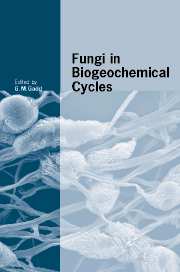Book contents
- Frontmatter
- Contents
- List of Contributors
- Preface
- 1 Geomicrobiology: relative roles of bacteria and fungi as geomicrobial agents
- 2 Integrated nutrient cycles in boreal forest ecosystems – the role of mycorrhizal fungi
- 3 Fungal roles in transport processes in soils
- 4 Water dynamics of mycorrhizas in arid soils
- 5 Integrating ectomycorrhizal fungi into quantitative frameworks of forest carbon and nitrogen cycling
- 6 Role of arbuscular mycorrhizal fungi in carbon and nutrient cycling in grassland
- 7 The role of wood decay fungi in the carbon and nitrogen dynamics of the forest floor
- 8 Relative roles of bacteria and fungi in polycyclic aromatic hydrocarbon biodegradation and bioremediation of contaminated soils
- 9 Biodegradation and biodeterioration of man-made polymeric materials
- 10 Fungal dissolution and transformation of minerals: significance for nutrient and metal mobility
- 11 Fungal activities in subaerial rock-inhabiting microbial communities
- 12 The oxalate–carbonate pathway in soil carbon storage: the role of fungi and oxalotrophic bacteria
- 13 Mineral tunnelling by fungi
- 14 Mineral dissolution by ectomycorrhizal fungi
- 15 Lichen biogeochemistry
- 16 Fungi in subterranean environments
- 17 The role of fungi in carbon and nitrogen cycles in freshwater ecosystems
- 18 Biogeochemical roles of fungi in marine and estuarine habitats
- Index
- References
14 - Mineral dissolution by ectomycorrhizal fungi
Published online by Cambridge University Press: 10 December 2009
- Frontmatter
- Contents
- List of Contributors
- Preface
- 1 Geomicrobiology: relative roles of bacteria and fungi as geomicrobial agents
- 2 Integrated nutrient cycles in boreal forest ecosystems – the role of mycorrhizal fungi
- 3 Fungal roles in transport processes in soils
- 4 Water dynamics of mycorrhizas in arid soils
- 5 Integrating ectomycorrhizal fungi into quantitative frameworks of forest carbon and nitrogen cycling
- 6 Role of arbuscular mycorrhizal fungi in carbon and nutrient cycling in grassland
- 7 The role of wood decay fungi in the carbon and nitrogen dynamics of the forest floor
- 8 Relative roles of bacteria and fungi in polycyclic aromatic hydrocarbon biodegradation and bioremediation of contaminated soils
- 9 Biodegradation and biodeterioration of man-made polymeric materials
- 10 Fungal dissolution and transformation of minerals: significance for nutrient and metal mobility
- 11 Fungal activities in subaerial rock-inhabiting microbial communities
- 12 The oxalate–carbonate pathway in soil carbon storage: the role of fungi and oxalotrophic bacteria
- 13 Mineral tunnelling by fungi
- 14 Mineral dissolution by ectomycorrhizal fungi
- 15 Lichen biogeochemistry
- 16 Fungi in subterranean environments
- 17 The role of fungi in carbon and nitrogen cycles in freshwater ecosystems
- 18 Biogeochemical roles of fungi in marine and estuarine habitats
- Index
- References
Summary
Introduction
Ectomycorrhizal fungi (EMF) form symbioses with forest trees. These fungi are mainly basidiomycetes and ascomycetes and they probably evolved from saprotrophic fungi when organic matter began to accumulate in certain soils 200 million years ago (Cairney, 2000). The tree host benefits from the symbiosis through improved nutrient acquisition since the fungus explores the soil efficiently for nutrients (especially N and P) in return for host carbon (Smith & Read, 1997). Forest trees with ectomycorrhiza usually dominate in acidic soils with thick litter layers, with the associated EMF forming extensive external mycelia with a high capacity to take up nutrients from the soil. The fungi form mantles around the root tips with large storage capacities (Read, 1991). The trees invest large amounts of carbon in the ectomycorrhizal (EM) symbionts, especially under nutrient-poor conditions, with up to 20% of photosynthetic assimilates allocated to the mycorrhizal symbionts (Finlay & Söderström, 1992). This large carbon source for EMF gives them an advantage over non-symbiotic microorganisms in the soil ecosystem since these are usually carbon-limited (Aldén et al., 2001). The importance of current photosynthate for soil processes was recently demonstrated by Högberg et al. (2001), who girdled trees in northern Sweden and found a rapid reduction in soil respiration of more than 50% within 1–2 months. More precise calculations the second year after girdling demonstrated that 65% of total respiration was contributed by EM roots, their associated EMF and other rhizosphere microorganisms (Bhupinderpal-Singh et al., 2003).
- Type
- Chapter
- Information
- Fungi in Biogeochemical Cycles , pp. 328 - 343Publisher: Cambridge University PressPrint publication year: 2006
References
- 5
- Cited by



